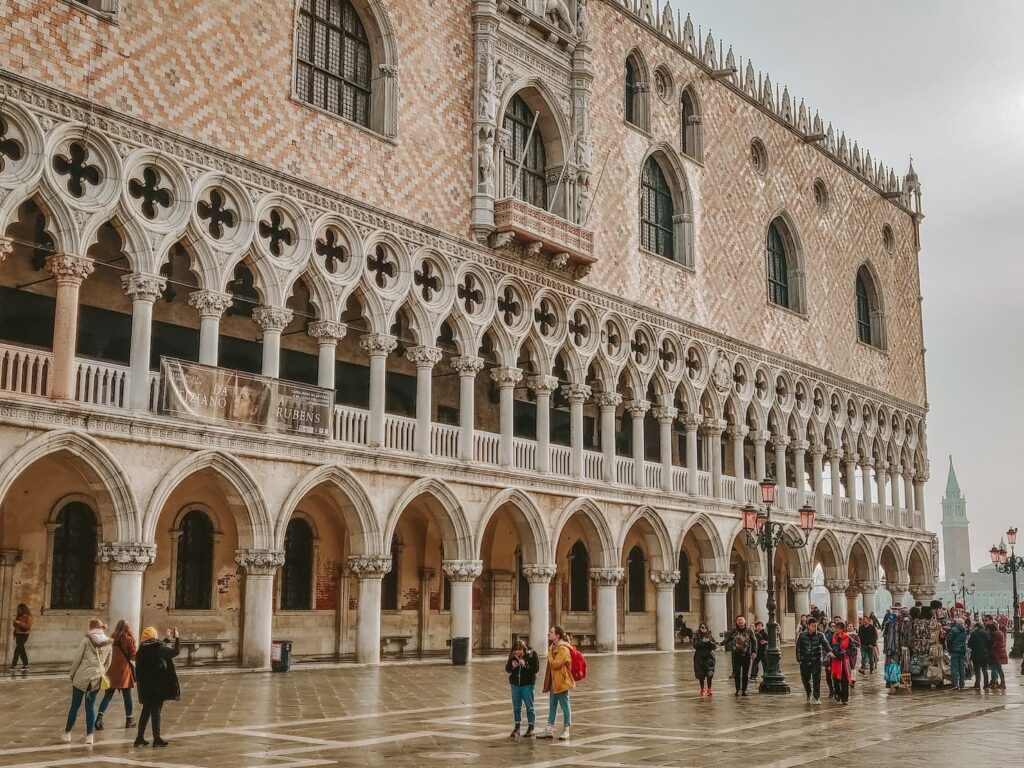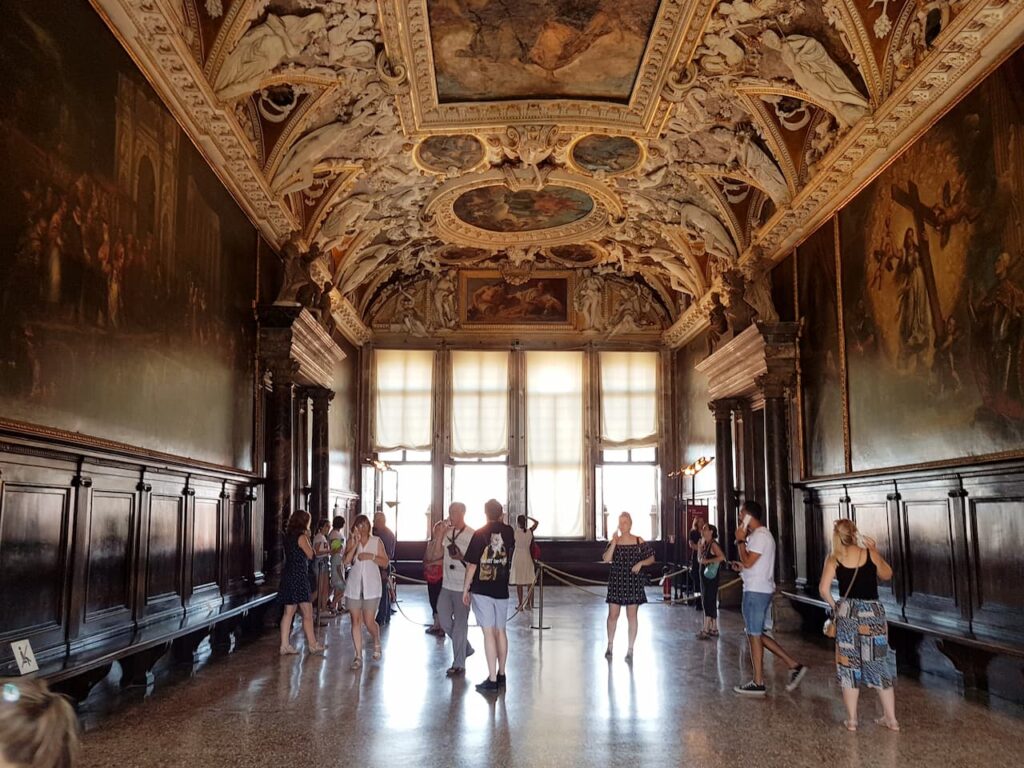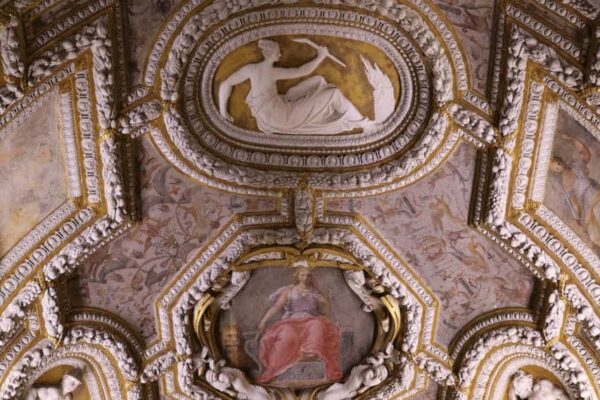The Room of the Four Doors is one of the best-known rooms in the Doge’s Palace in Venice. In this article we will discover together what the function of this room was, when it was built and what works of art are inside.
Before we start, a brief preamble: if you plan to visit the Doge’s Palace in Venice, the Hall of the Four Doors and all the other rooms, it is strongly recommended to buy your ticket online, to avoid the long queue that may form at the ticket office. By purchasing your ticket in advance, you will be able to enter the Palace skipping the queue.

Doge’s Palace skip-the-line ticket: quick access
Buy online. Choose the time you prefer. Visit the Doge’s Palace in Venice, the Bridge of Sighs, the prisons and more.
You can cancel free of charge up to the day before your visit.
Chamber of the Four Doors: history and architecture

The Sala delle Quattro Porte (Hall of the Four Doors) in the Doge’s Palace in Venice was a room with the function of an antechamber, where the high representatives of the government stayed before entering the four rooms where the assemblies of the College, the Senate, the Council of Ten and the Chancellery took place.
The hall takes its name from the four monumental doors on two of the walls, designed by Andrea Palladio.
The architraves of the portals are supported by Corinthian columns, each with a related sculptural group evoking the tasks of the governing bodies of the halls to which they gave access:
- Vigilance, Eloquence, The Ease of Audience for the College
- Peace, Pallas, War for the Senate
- Authority, Religion, Justice for the Council of Ten
- Secrecy, Diligence, Fidelity for the Chancellery.
The hall was restored after the fire of 1574, according to designs by Andrea Palladio and Giovanni Antonio Rusconi. The barrel vault is decorated with gold and stucco work by Giovanni Battista Cambi known as Bombarda.
Room of the Four Doors: works and paintings

The choice of decorative programme was the work of the polygraph Francesco Sansovino.
Although there are very conflicting traditions on the foundation of Venice (according to some sources it was built by Trojan refugees), for this room Sansovino was inspired by the tradition that Venice was founded by Jupiter, stating the following
Venetia is sent by Jupiter to these waters, because it was made by God’s disposition so that Christian religion and freedom would be preserved there
The events depicted on the ceiling are thus dedicated to the mythical foundation of the city and its dominion over the sea.
The oval canvases include personifications of Venice and cities subjected to it.
The frescoes dedicated to Istria, The City of Brescia and The City of Padua are the work of Niccolò Bambini, while that of The City of Verona is by Ermolao Paoletti.
On the largest compartments are four works by Nicolò Bambini, representing:
- in the centre, with his back to the Square Atrium, Jupiter gives Venice dominion over the Adriatic;
- on the left, Juno offers Venice the peacock and the thunderbolt;
- on the right, Venice breaks the yoke of slavery.
Dating back to 1758 is the painting Neptune Offers Gifts to Venice, by Giambattista Tiepolo, now placed on an easel but formerly part of the ceiling cycle.
In addition to the marvellous paintings, the vault is decorated with grotesques, a type of decoration very much in vogue at the end of the 15th century and in the 16th century, with subjects freely taken from classical antiquity, including allegorical figures, divinities, putti, winged genii, sirens and tritons.
The decoration on the walls includes votive scenes and re-enactments of historical events, looking at the decorations from left to right:
- Offering the symbols of a city to Emperor Augustus, Anonymous
- The Arrival in Venice of King Henry III, Andrea Micheli called Il Vicentino
- The Ploughing, Anonymous
- The Doge Marino Grimani Receives Gifts from the Persian Ambassadors, Gabriele Caliari
- The Venetians Conquer Verona, Giovanni Contarini
- Episode of Roman History, Anonymous
- The Doge Antonio Grimani in Adoration of the Faith at St. Mark’s in Glory, Tiziano Vecellio
- Bishop, Anonymous
- Offering the symbols of a city subjugated by the Romans, Anonymous
- Doge Marino Grimani in front of the Virgin, Giovanni Contarini
Conclusions
Here we are at the end of this short article on the history, architecture and works of the Room of the Four Doors. If you need more information about the interior of the Doges’ Palace, find out more about the history of the Chamber of the Great Councils or leave a comment below.

Skip-the-line ticket Doge’s Palace Venice: Quick access
Buy online. Choose the time you prefer. Visit the Doge’s Palace in Venice, the Hall of the Great Council, the prisons and much more.
You can cancel for free up to the day before your visit.
Photo credits:
- Sala delle Quattro Porte: Photo by Ricardalovesmonuments via Wikimedia
- Dipindi Sala delle Quattro Porte: Photo by Joanbanjo via Wikimedia


